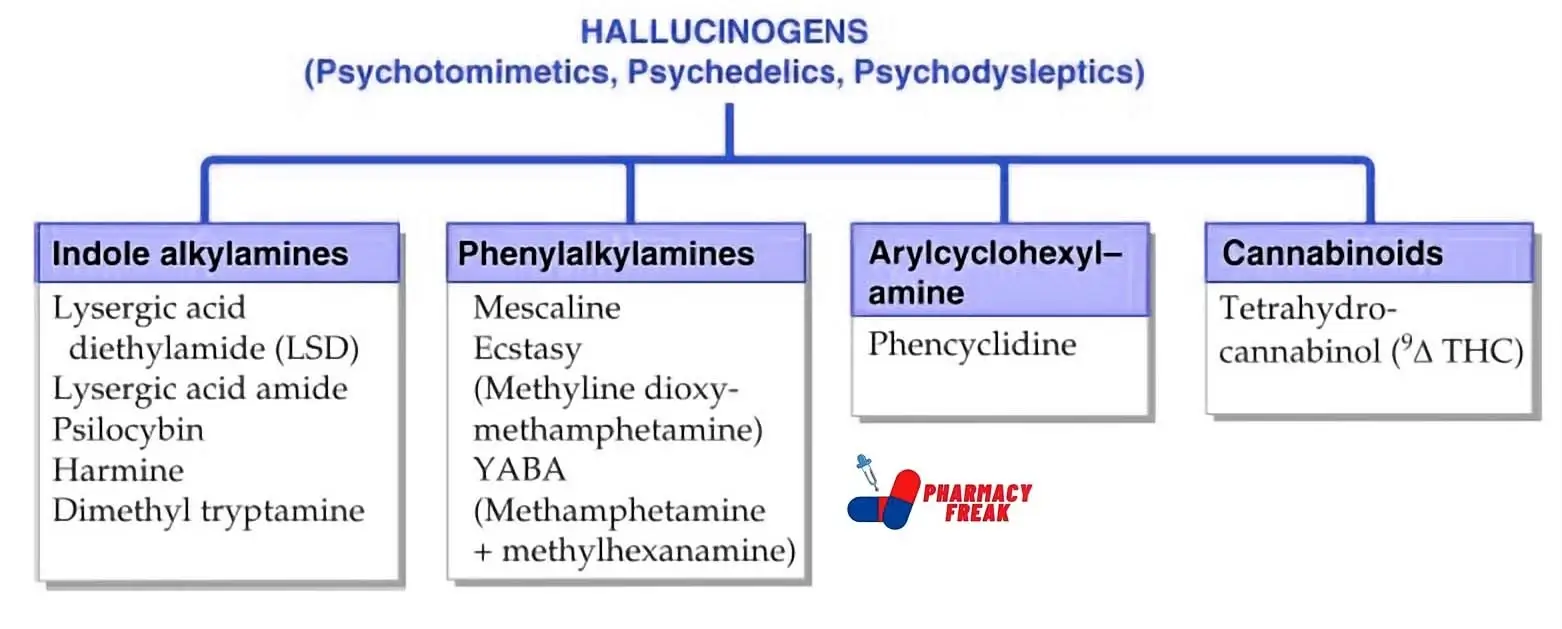Hallucinogens (Psychotomimetics, Psychedelics, Psychodysleptics) – the name itself can conjure up a sense of mystery and wonder. These mind-altering substances have been part of human culture for centuries, used in various ways for spiritual, recreational, or medicinal purposes.
Table of Contents
What are Hallucinogens?
Hallucinogens, often called psychedelics or mind-altering drugs, are substances that profoundly affect a person’s thoughts, feelings, and sensory perceptions. They can cause hallucinations, where individuals see, hear, or feel things that aren’t real.
Classification
HALLUCINOGENS (Psychotomimetics, Psychedelics, Psychodysleptics)
- Indole alkylamines- Lysergic acid diethylamide (LSD), Lysergic acid amide, Psilocybin, Harmine, Dimethyl tryptamine
- Phenylalkylamines– Mescaline,Ecstasy (Methyline dioxy- methamphetamine),YABA (Methamphetamine + methylhexanamine)
- Arylcyclohexyl- amine- Phencyclidine
- Cannabinoids- Tetrahydro-cannabinol
Classic Hallucinogens
These are the well-known hallucinogens, and they include:
- LSD (Lysergic Acid Diethylamide): LSD, also known as “acid,” is one of the most famous hallucinogens. It’s synthesized from a fungus that grows on rye.
- Psilocybin (Magic Mushrooms): Psilocybin is found in certain mushrooms, commonly known as magic mushrooms or shrooms. They’ve been used for centuries in various cultural and spiritual practices.
- Mescaline: Mescaline is found in the peyote cactus and the San Pedro cactus. Native American tribes have used peyote in religious ceremonies.
Dissociative Hallucinogens
These substances can cause individuals to feel detached from their bodies, leading to a sense of dissociation from reality. Some examples include:
- Ketamine: Ketamine is used medically as an anesthetic but is also a popular recreational drug, known for its dissociative effects.
- PCP (Phencyclidine): PCP, also called “angel dust,” can induce hallucinations and a sense of detachment from one’s surroundings.
Deliriants
Deliriants induce a state of delirium in users, characterized by confusion, disorientation, and vivid hallucinations. A classic example is:
- Datura: Plants like Datura contain toxic compounds that can lead to powerful and often disturbing hallucinations.
Research Chemicals
This is a broad category that includes synthetic substances created in labs. They often mimic the effects of classic hallucinogens and are designed to evade legal restrictions.
Ayahuasca
Ayahuasca is a brew made from specific plants found in the Amazon rainforest. It contains DMT, a potent hallucinogen. It’s used in shamanic ceremonies for its spiritual and therapeutic effects.
Salvia Divinorum
Salvia divinorum is a plant native to Mexico. It contains salvinorin A, a potent hallucinogen. It’s known for its short but intense effects.
Reference
- Classification of Progestins- KD Tripathi
- National Library of Medicine- Psychedelic and Dissociative Drugs
Related Links

I am a Registered Pharmacist under the Pharmacy Act, 1948, and the founder of PharmacyFreak.com. I hold a Bachelor of Pharmacy degree from Rungta College of Pharmaceutical Science and Research. With a strong academic foundation and practical knowledge, I am committed to providing accurate, easy-to-understand content to support pharmacy students and professionals. My aim is to make complex pharmaceutical concepts accessible and useful for real-world application.
Mail- Sachin@pharmacyfreak.com
